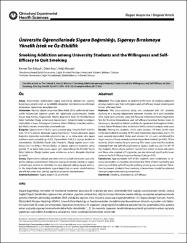| dc.contributor.author | Selçuk, Kevser Tarı | |
| dc.contributor.author | Temizer, Dilek Avcı | |
| dc.contributor.author | Mercan, Yeliz | |
| dc.date.accessioned | 2021-12-12T16:51:08Z | |
| dc.date.available | 2021-12-12T16:51:08Z | |
| dc.date.issued | 2018 | |
| dc.identifier.issn | 2459-1459 | |
| dc.identifier.issn | 2459-1459 | |
| dc.identifier.uri | https://doi.org/10.5152/clinexphealthsci.2017.420 | |
| dc.identifier.uri | https://app.trdizin.gov.tr/makale/TXpjME9EYzNOdz09 | |
| dc.identifier.uri | https://hdl.handle.net/20.500.11857/2489 | |
| dc.description.abstract | Amaç: Araştırmada öğrencilerin sigara bağımlılığı derecesinin, sigarayıbırakmaya yönelik istek ve öz-etkililik düzeyinin belirlenmesi ve etkileyenetmenlerin saptanması amaçlanmıştır.Yöntemler: Kesitsel tipteki araştırma Ekim-Aralık 2016 tarihinde bir hemşirelik bölümünde öğrenim gören 301 öğrenciyle yürütülmüştür. VerilerKişisel Bilgi Formu, Fagerström Nikotin Bağımlılık Testi, Öz Etkililik/TeşvikEden Faktörler Ölçeği kullanılarak toplanmıştır. Çözümlemede tanımlayıcıistatistikler, ki kare, Kolmogrow Smirnow, Mann Whitney U testleri ve Kruskall Wallis varyans analizinden yararlanılmıştır.Bulgular: Öğrencilerin %18,3’ü sigara içmekte olup, %56,4’ü hafif, %30,9’uorta, %12,7’si yüksek derecede sigara bağımlısıdır. Yüksek derecede sigarabağımlısı öğrenciler içerisinde erkeklerin, beş yıl ve daha uzun süre sigaraiçenlerin oranı yüksektir (p<0,05). Öğrencilerin %38,2’si sigarayı bırakmakistemektedir, Öz-Etkililik/Teşvik Edici Faktörler Ölçeği toplam puan ortalaması 23,71±5,89’dur. Annesi ilkokul ve altında öğrenim düzeyine sahip,günlük 11 ve daha fazla sayıda sigara içen öğrencilerde Öz-Etkililik/ TeşvikEdici Faktörler Ölçeği toplam puan ortalaması anlamlı düzeyde düşüktür(p<0,05).Sonuç: Öğrencilerin yaklaşık yarısının orta ve yüksek derecede sigara bağımlısı olduğu, üçte birinden fazlasının sigarayı bırakmak istediği ve sigarayı bırakmaya yönelik öz-etkililiklerinin orta düzeyde olduğu tespit edilmiştir. Bu doğrultuda öğrencilerde sigara bağımlılığının erken müdahalesineyönelik kurumlar arası işbirliği yapılarak girişimler planlanmalıdır. | en_US |
| dc.description.abstract | Objective: The study aimed to determine the level of smoking addiction among students and their willingness and self-efficacy to quit smoking and factors affecting them. Methods: This cross-sectional study was conducted with 301 students studying in a nursing department between October 2016 and December 2016. Data were collected using the Personal Information Form, Fagerström Test for Nicotine Dependence, and Self-efficacy/Incentive Factors Scale. In the analysis, descriptive statistics and the chi square test, Kolmogorov-Smirnov test, Mann-Whitney U test, and Kruskal-Wallis variance analysis were used. Results: Among the students, 18.3% were smokers. Of them, 56.4% were mildly dependent in nicotine, 30.9% were moderately dependent, and 12.7% were severely dependent. Males and smokers for ?5 years constituted the larger portion of these severely nicotine-dependent students (p<0.05). Of the students, 38.2% wanted to quit smoking. The mean score that the students obtained from the Self-efficacy/Incentive Factors Scale was 23.71±5.89. Of the students, those whose mothers had primary school or lower education and those who smoked ?11 cigarettes per day obtained significantly lower scores in the Self-Efficacy/Incentive Factors Scale (p<0.05). Conclusion: Approximately half of the students were moderately or severely dependent on nicotine, more than one-third of them wanted to quit smoking, and their self-efficacy for quitting smoking was moderate. Therefore, to prevent students from smoking, interventions should be planned through cooperation among institutions. | en_US |
| dc.language.iso | tur | en_US |
| dc.relation.ispartof | Clinical and Experimental Health Sciences | en_US |
| dc.identifier.doi | 10.5152/clinexphealthsci.2017.420 | |
| dc.rights | info:eu-repo/semantics/openAccess | en_US |
| dc.subject | [No Keywords] | en_US |
| dc.title | Üniversite Öğrencilerinde Sigara Bağımlılığı, Sigarayı Bırakmaya Yönelik İstek ve Öz-Etkililik | en_US |
| dc.title.alternative | Smoking Addiction among University Students and the Willingness and SelfEfficacy to Quit Smoking | en_US |
| dc.type | article | |
| dc.department | Fakülteler, Sağlık Bilimleri Fakültesi, Sağlık Yönetimi Bölümü | |
| dc.identifier.volume | 8 | en_US |
| dc.identifier.startpage | 36 | en_US |
| dc.identifier.issue | 1 | en_US |
| dc.identifier.endpage | 43 | en_US |
| dc.relation.publicationcategory | Makale - Uluslararası Hakemli Dergi - Kurum Öğretim Elemanı | en_US |
| dc.identifier.wos | WOS:000432828600006 | en_US |



















